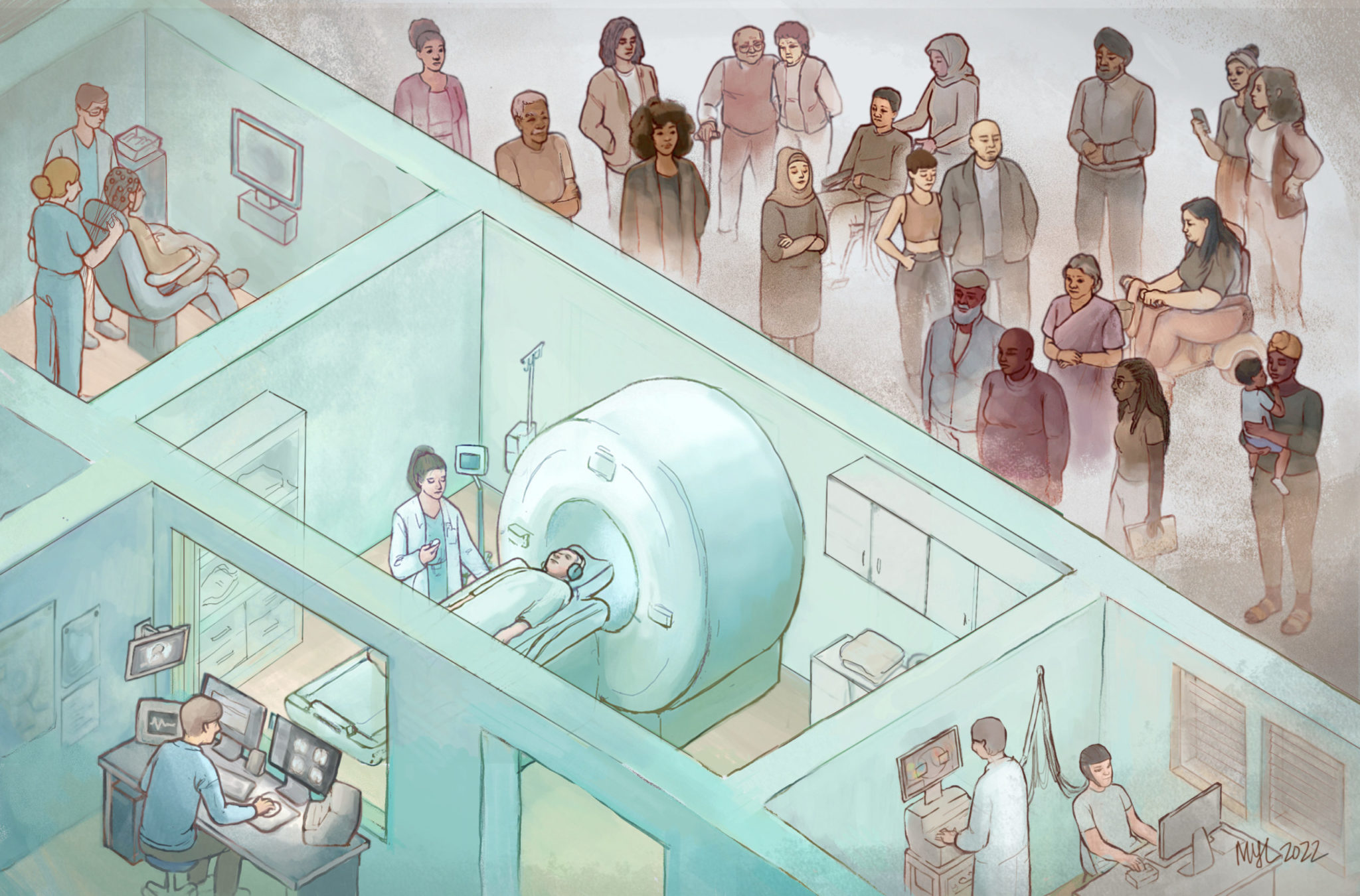Yale researchers confront racially exclusionary practices in neuroimaging
A failure to diversify clinical trial participation could endanger scientific research’s ability to represent a diverse population; standard practices in neuroimaging were shown to exclude marginalized populations from participating.

Work commissioned from Mona Li by the researchers
Termara Parker GRD ’23 said she has never been considered a “good” candidate for brain imaging. Her hair is considered too thick for an adequate brain signal to be recorded, and is often in protective styles — used to maintain Black hair — such as braids or twists.
Parker, who recently earned her doctoral degree in neuroscience, has been conducting neuroimaging research since 2015. Early on, she noticed that the people coming in to participate in neuroimaging research studies were predominantly white and Asian. Meanwhile, the imaging technology was unable to retrieve sufficient brain signals for the Black and Brown people with coarser, curlier hair. In a paper published in Nature Neuroscience, Parker and other Yale researchers called upon the science community to address racially exclusionary practices in neuroimaging.
“As scientists, our whole job is to try to understand the world better,” Parker said. “How can we really be helpful to society if the research practices that we do lead to participants that may not necessarily reflect the general population?”
According to the U.S. Food and Drug Administration, Black people constitute only five percent of participants in clinical research, despite making up 13.6 percent of the U.S. population. 95 percent of the UK Biobank, the world’s largest collection of neuroimaging data, is drawn from white participants.
The exclusion of marginalized populations from neuroimaging is worrisome, Parker explained, because neuroimaging studies help scientists understand the brain’s role in behavior and social interaction. The one-size-fits-all approach to neuroimaging could distort understanding of brain-behavior relationships.
“One of the most important things in science is generalizability,” said Jocelyn Ricard, a lead author on the study and post-baccalaureate researcher in psychology. “And if we are drawing upon an overwhelmingly homogeneous sample, for example, it can lead to biased results, especially in an ever-growing globalized world.”
The physical barriers presented by neuroimaging technology represent one of the challenges to recruiting underrepresented populations for clinical studies.
According to Parker, for electroencephalography, or EEG, to successfully pick up electrical signals coming from the brain, the EEG cap, which is worn over the head, must make adequate contact with the scalp. If a participant has coarse, curly hair, a thick afro or has a protective style such as braids, it is difficult for the electrodes of the EEG cap to make contact with the scalp. As a result, performing EEG on these participants often produces “noisy,” unusable data, Parker explained — in some cases, the cap is not able to even fit over the person’s head.
Functional near infrared spectroscopy, or fNIRS, is another form of neuroimaging that has trouble working on participants with coarse, curly hair, Parker noted, with the added issue of fNIRS being an optical tool. The infrared light fNIRS uses must be able to pass through the hair and skin to record clear data. However, melanin can act as a barrier to this kind of light, leading to an inadequate signal, Parker explained. People with darker skin tones and coarser hair, including Black and Latino populations, are often excluded from these neuroimaging studies as a result.
“If I have data about the brain that centers and elevates those of European descent and treats people from other ancestries as an afterthought, I constrain the information I have to work with and limit my solution space,” AZA Allsop, a contributing author on the study and fourth-year psychiatry resident, wrote to the News. “The science we do should reflect the diverse range of people that suffer and need solutions.”
Parker’s doctoral research focused on the neural mechanisms of eye gaze in autistic individuals and involved usage of fNIRS. Despite her work being inspired by her sister, a Black woman with autism, Parker ended up being unable to recruit a Black autistic individual for the study. This “frustrated” her, she said, noting that data collected from one homogenous population would not necessarily apply to other autistic individuals.
Another barrier to diverse participation described in the paper was ongoing mistrust of scientific and medical institutions among marginalized populations. One example source of this mistrust is the Tuskegee experiment, which led to the death of nearly one hundred Black men who were withheld treatment for syphilis.
Parker hopes this paper serves as a call to action, particularly for the general science population who often views these barriers as “an inconvenience” rather than a systemic issue.
“There can be a feeling of complacency, as though things are just the way they are,” Ricard said. “But what makes science so unique is that we are well positioned to answer these questions and figure out solutions.”
Avram Holmes, senior author of the study and associate professor of psychology and of psychiatry, said there has recently been increased acknowledgement of explicit and unrecognized racism in academia. While such efforts have focused mainly on diversity in recruitment, training and retention within the profession, this article draws attention to the “parallel set of issues” embedded in the process of scientific discovery itself, threatening the reliability, equity and generalizability of discoveries.
“Science cannot help society if it does not reflect society,” Parker concluded.
76 percent of data for the Human Connectome Project, a large U.S.-based neuroimaging project, was collected from white individuals.







